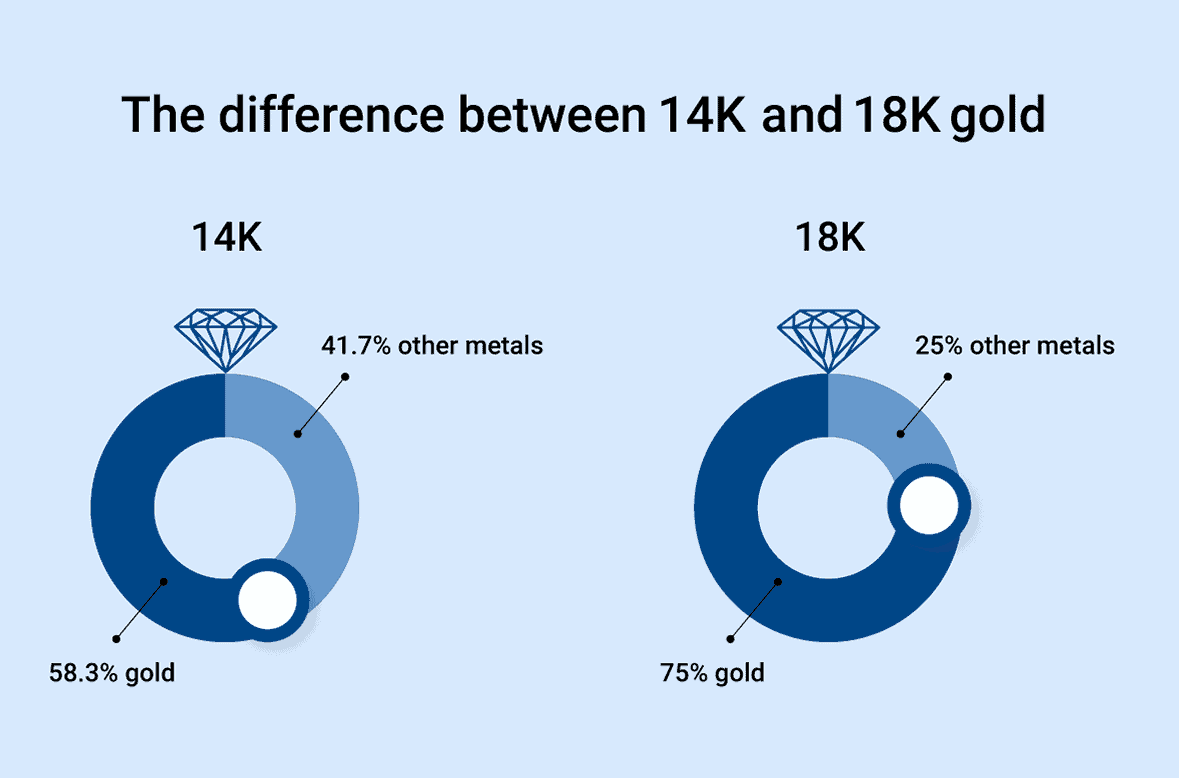Your Cart is Empty
Site under development -30% on the General Public Collection / CODE: "ICEVVS " - LIMITED STOCK
Site under development -30% on the General Public Collection / CODE: "ICEVVS " - LIMITED STOCK


Whether you're shopping for jewelry or an engagement ring online or offline, you've probably noticed that most settings are available in two different types of gold: 14K and 18K.
18K gold consists of 18 parts pure gold mixed with 6 parts other metals. Depending on the color of the gold (e.g., white gold, yellow gold, or rose gold), these metals can be nickel, silver, copper, zinc, and palladium. Expressed as a percentage, 18-karat gold is 75% pure gold.
14-karat gold, on the other hand, consists of 14 parts pure gold mixed with 10 parts other metals, the latter varying depending on the color of the gold. Expressed as a percentage, the pure gold in a 14-karat gold jewelry piece represents 58.3% of the total metal.
In the United States, most engagement rings are made of 14 karat (14K) gold. However, it is also common for some engagement ring settings to be made of 18 karat gold. While these two types of gold may look similar, they actually have several key differences.
Below, we explain these differences, as well as what you need to know if you're struggling to decide between 14K and 18K gold for an engagement ring, necklace, bracelet, pair of earrings, or any other fine jewelry piece.
Looking to sell your gold? This article is intended to help those looking to buy jewelry. If you're looking to sell your gold, feel free to check out our Selling Your Jewelry page. If you're looking to sell your diamond engagement ring, we have a specific article on selling diamonds.
Contrary to popular belief, the gold jewelry you buy is generally not made of pure gold. In fact, almost all gold jewelry is made from an alloy created by combining pure gold with a variety of other metals.
| Carats | Gold percentage | Purity % | Millimeter fineness |
|---|---|---|---|
| 18K | 18/24 | 75 | 750 |
| 14K | 14/24 | 58.3 | 583/585 |
The reason for this is that pure gold is very soft. If engagement rings, earrings, and other jewelry were made of pure gold, they would scratch, scuff, dent, and warp very easily, often simply by brushing against another surface.
There's also the issue of color: instead of the warm golden color most of us associate with gold jewelry, pure gold actually has a color closer to orange.
This is why modern gold jewelry uses gold mixed with other metals. The purity of this gold is measured using the karat system, which provides information on the percentage of pure gold contained in any type of gold.

Both 14K and 18K gold are commonly used for engagement rings—in fact, they're both very popular options for engagement ring settings. Both types of gold have their own unique pros and cons, whether it's appearance, cost, durability, or other aspects. We've listed them below.
14K gold has several advantages. First, it's affordable. Since pure gold represents 58.3% of the metal content of 14K gold, a 14K gold engagement ring will generally cost slightly less than the same ring in 18K gold.
Second, 14K gold is quite durable. Gold is a soft, malleable metal that easily scratches, bends, and warps. This means that the purer a gold engagement ring is, the easier it is to scratch door frames, desks, tables, floors, and other surfaces.
While 14-karat gold isn't as durable as platinum or palladium, it's more than durable enough for the average person. It's also much more durable than 18-karat gold, making it the best choice if your fiancée-to-be has an active lifestyle or works with her hands.
Third, while 14-karat gold isn't as pure as 18-karat gold, its relatively high pure gold content allows it to retain the warmth and rich color that people associate with gold. While it may appear slightly dull when compared to 18-karat gold, 14-karat gold is dazzling on its own.
Finally, 14-karat gold is ubiquitous and widely available in the world of engagement rings. It's by far the most popular type of gold for engagement rings, accounting for approximately 90% of all rings sold in the US, UK, and other Western countries. It's therefore an easy option to find.
14-karat gold is popular for a very specific reason: for most people, it's the best choice. However, it does have some minor drawbacks.
First of all, for some people, 14k gold is not as aesthetically pleasing as 18k gold. Although its color is rich and impressive, the appearance of 14K gold is not as strong as 18K gold due to its lower purity.
Second, while unlikely for either type of gold, 14-karat gold is slightly more likely to cause skin allergies than 18-karat gold. If your future fiancé(e) is allergic to silver, copper, nickel, zinc, or iron, this could be a point in favor of 18-karat gold.
The main advantage of 18-karat gold is its purity. As the purest form of gold suitable for an engagement ring, an 18-karat gold ring offers the beautiful look of near-pure gold with most of the practical benefits of an alloy.
This extra purity can be particularly evident with 18K yellow or rose gold, which tends to exhibit a warmer, more vibrant tone in 18K gold than in 14K gold.
The higher purity level of 18K gold also makes it less likely to trigger skin allergies than 14K or 10K gold. While 18K gold still contains nickel and other alloying metals, they are present only in small amounts, making the risk of contact dermatitis or other allergic reactions very low.
Unfortunately, 18-karat gold's greatest advantage—its purity—is also its greatest disadvantage. Due to its higher percentage of pure gold, 18-karat gold is significantly softer and easier to scratch or dent than 14-karat gold.
This means that if your future fiancée works with her hands or has an active lifestyle, an 18k gold ring may not be the best choice.
Another disadvantage of 18-karat gold is its price. As we briefly mentioned above, 18-karat gold costs significantly more than 14-karat gold, with most 18-karat gold engagement rings selling for 150% to 200% more than their 14-karat gold counterparts.
Both 14K and 18K gold are excellent metal choices for an engagement ring, although each suits a different type of person.
If your fiancée-to-be is very active or works with her hands, a 14k gold engagement ring will be a better choice. Not only will it be more durable than an 18k gold ring, but it will also cost a little less while still looking absolutely stunning. Joey King's engagement ring is made of yellow or rose gold, and while we don't know if it's 14K or 18K gold, it is simply stunning.
As mentioned above, 14K gold is used in approximately 90% of engagement rings sold for the following reasons: it is beautiful, affordable, and durable.
If you're not concerned about durability and want the purest form of gold while still being practical for an engagement ring, 18-karat gold may be a better choice. Be aware, however, that this type of gold can and often does scratch, meaning your future fiancé will need to be more careful.
Finally, if your future fiancé is allergic to nickel, 18-karat gold is a better choice than 14-karat gold because it is less likely to cause contact dermatitis.